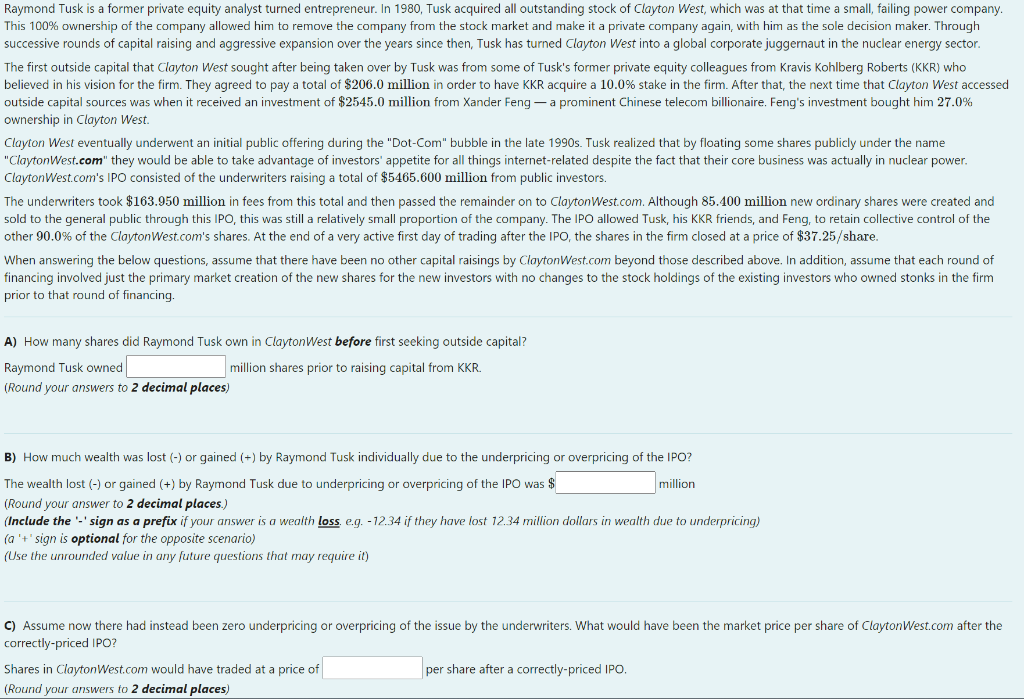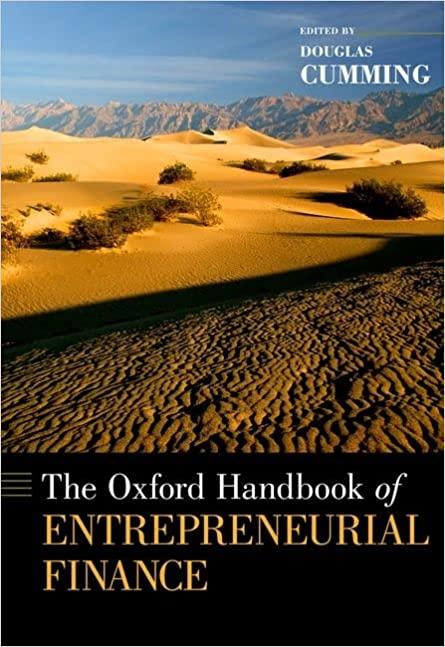
Raymond Tusk is a former private equity analyst turned entrepreneur. In 1980, Tusk acquired all outstanding stock of Clayton West, which was at that time a small, failing power company. This 100% ownership of the company allowed him to remove the company from the stock market and make it a private company again with him as the sole decision maker. Through successive rounds of capital raising and aggressive expansion over the years since then, Tusk has turned Clayton West into a global corporate juggernaut in the nuclear energy sector. The first outside capital that Clayton West sought after being taken over by Tusk was from some of Tusk's former private equity colleagues from Kravis Kohlberg Roberts (KKR) who believed in his vision for the firm. They agreed to pay a total of $206.0 million in order to have KKR acquire a 10.0% stake in the firm. After that, the next time that Clayton West accessed outside capital sources was when it received an investment of $2545.0 million from Xander Feng - a prominent Chinese telecom billionaire. Feng's investment bought him 27.0% ownership in Clayton West. Clayton West eventually underwent an initial public offering during the "Dot-Com" bubble in the late 1990s. Tusk realized that by floating some shares publicly under the name "ClaytonWest.com" they would be able to take advantage of investors' appetite for all things internet-related despite the fact that their core business was actually in nuclear power. Clayton West.com's IPO consisted of the underwriters raising a total of $5465.600 million from public investors. The underwriters took $163.950 million in fees from this total and then passed the remainder on to Clayton West.com. Although 85.400 million new ordinary shares were created and sold to the general public through this IPO, this was still a relatively small proportion of the company. The IPO allowed Tusk, his KKR friends, and Feng, to retain collective control of the other 90.0% of the Clayton West.com's shares. At the end of a very active first day of trading after the IPO, the shares in the firm closed at a price of $37.25/share. When answering the below questions, assume that there have been no other capital raisings by Clayton West.com beyond those described above. In addition, assume that each round of financing involved just the primary market creation of the new shares for the new investors with no changes to the stock holdings of the existing investors who owned stonks in the firm prior to that round of financing, A) How many shares did Raymond Tusk own in Clayton West before first seeking outside capital? Raymond Tusk owned million shares prior to raising capital from KKR. (Round your answers to 2 decimal places) B) How much wealth was lost (-) or gained (+) by Raymond Tusk individually due to the underpricing or overpricing of the IPO? The wealth lost (-) or gained (+) by Raymond Tusk due to underpricing or overpricing of the IPO was $ million (Round your answer to 2 decimal places.) (Include the '-' sign as a prefix if your answer is a wealth loss. e.g. - 12.34 if they have lost 12.34 million dollars in wealth due to underpricing) (a'+' sign is optional for the opposite scenario) (Use the unrounded value in any future questions that may require it) C) Assume now there had instead been zero underpricing or overpricing of the issue by the underwriters. What would have been the market price per share of Clayton West.com after the correctly-priced IPO? Shares in Clayton West.com would have traded at a price of per share after a correctly-priced IPO. (Round your answers to 2 decimal places) Raymond Tusk is a former private equity analyst turned entrepreneur. In 1980, Tusk acquired all outstanding stock of Clayton West, which was at that time a small, failing power company. This 100% ownership of the company allowed him to remove the company from the stock market and make it a private company again with him as the sole decision maker. Through successive rounds of capital raising and aggressive expansion over the years since then, Tusk has turned Clayton West into a global corporate juggernaut in the nuclear energy sector. The first outside capital that Clayton West sought after being taken over by Tusk was from some of Tusk's former private equity colleagues from Kravis Kohlberg Roberts (KKR) who believed in his vision for the firm. They agreed to pay a total of $206.0 million in order to have KKR acquire a 10.0% stake in the firm. After that, the next time that Clayton West accessed outside capital sources was when it received an investment of $2545.0 million from Xander Feng - a prominent Chinese telecom billionaire. Feng's investment bought him 27.0% ownership in Clayton West. Clayton West eventually underwent an initial public offering during the "Dot-Com" bubble in the late 1990s. Tusk realized that by floating some shares publicly under the name "ClaytonWest.com" they would be able to take advantage of investors' appetite for all things internet-related despite the fact that their core business was actually in nuclear power. Clayton West.com's IPO consisted of the underwriters raising a total of $5465.600 million from public investors. The underwriters took $163.950 million in fees from this total and then passed the remainder on to Clayton West.com. Although 85.400 million new ordinary shares were created and sold to the general public through this IPO, this was still a relatively small proportion of the company. The IPO allowed Tusk, his KKR friends, and Feng, to retain collective control of the other 90.0% of the Clayton West.com's shares. At the end of a very active first day of trading after the IPO, the shares in the firm closed at a price of $37.25/share. When answering the below questions, assume that there have been no other capital raisings by Clayton West.com beyond those described above. In addition, assume that each round of financing involved just the primary market creation of the new shares for the new investors with no changes to the stock holdings of the existing investors who owned stonks in the firm prior to that round of financing, A) How many shares did Raymond Tusk own in Clayton West before first seeking outside capital? Raymond Tusk owned million shares prior to raising capital from KKR. (Round your answers to 2 decimal places) B) How much wealth was lost (-) or gained (+) by Raymond Tusk individually due to the underpricing or overpricing of the IPO? The wealth lost (-) or gained (+) by Raymond Tusk due to underpricing or overpricing of the IPO was $ million (Round your answer to 2 decimal places.) (Include the '-' sign as a prefix if your answer is a wealth loss. e.g. - 12.34 if they have lost 12.34 million dollars in wealth due to underpricing) (a'+' sign is optional for the opposite scenario) (Use the unrounded value in any future questions that may require it) C) Assume now there had instead been zero underpricing or overpricing of the issue by the underwriters. What would have been the market price per share of Clayton West.com after the correctly-priced IPO? Shares in Clayton West.com would have traded at a price of per share after a correctly-priced IPO. (Round your answers to 2 decimal places)







